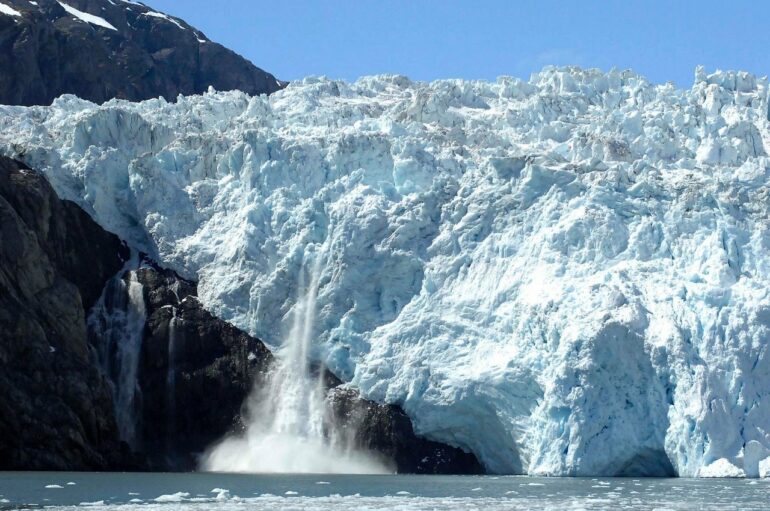The climate modeling community has been particularly vexed by the glacial/interglacial cycles of the past three million years, when the Northern Hemisphere oscillated between times with and without large ice sheets.
From about 1.25 million to 750,000 years ago—in the Pleistocene epoch—a change in glacial cycles called the Mid-Pleistocene Transition (MPT) occurred. During this time, glacial/interglacial cycles shifted from occurring every 41,000 years to every 100,000 years, with an increase in the amplitude and asymmetry of the cycles.
Scientists are working to understand why these changes happened, considering that insolation forcing—variation in energy that Earth receives from the sun—does not on its own explain the change.
Now, scientists from the Mann Research Group in the School of Arts & Sciences at the University of Pennsylvania and the Potsdam Institute for Climate Impact Research have found strong path dependence, also known as hysteresis behavior, in the evolution of Plio-Pleistocene glaciations. This means the evolution of glaciations isn’t only a function of factors such as carbon dioxide levels and solar output, but also that it is constrained by previous events.
They show that a gradual decrease in both regolith—sediment that prevents the growth of large ice sheets—and in volcanic outgassing, when eruptions release carbon dioxide into the atmosphere, are required to produce the MPT. Their findings were published in Proceedings of the National Academy of Sciences.
“What we have seen in this study is that with the same amount of volcanic outgassing, the model calculates different concentrations of atmospheric CO2. This indicates that the carbon cycle does not behave linearly and depends on its initial state,” says first author Judit Carrillo, a postdoctoral fellow in the Mann Research Group.
Climate scientist Michael E. Mann says these results indicate it’s not too late to act to keep present-day ice sheets from collapsing.
The researchers explain that the model determines where the carbon dioxide that is outgassed by volcanoes goes. This could help scientists better predict the impact of human-caused greenhouse gas emissions, says Carrillo.
This research used the CLIMBER-2 Earth system model of intermediate complexity, which includes atmosphere, ocean, ice sheet, and carbon cycle components. Mann explains that this model allows researchers to do simulations of millions of years, which wouldn’t be possible with the most complex and detailed models.
Matteo Willeit of the Potsdam Institute, a co-author on the paper, led a 2019 study using this model to reproduce the main features of the Plio-Pleistocene glacial/interglacial cycles.
In the new study, the researchers built on the 2019 paper by driving the model forward and backward in time over the past three million years, testing different regolith configurations to assess their impact on the MPT. The results suggest that depleted regolith and lowered CO2 levels are required to produce the 100,000-year, sawtooth-shaped cycle, but that carbon dioxide determines the onset of the MPT more fundamentally than the rate of regolith depletion.
“We find that this evolution is path dependent and, to be specific, not reversible in time,” the authors conclude. “In experiments beginning with modern preindustrial conditions and driving the model back in time with time-reversed Earth orbital and tectonic forcing, the warm, relatively ice-free conditions of the late Pliocene and early Pleistocene are not reproduced.”
Mann adds that this finding potentially has broader implications. “The fact that ice sheet extent depends not just on carbon dioxide concentrations by the direction in time, i.e. whether the climate is in a cooling or warming phase, provides a little bit of good news,” he says.
“Even though ice sheet extent was greatly diminished, and sea level substantially higher the last time carbon dioxide levels were as high as they are today several million years ago, the collapse of ice sheets is probably not yet locked in. We’ve got a bit of a cushion if we can bring carbon emissions down dramatically and quickly.”
The researchers caution that because the simulations are based on a single model, and because long-term simulations of glacial/interglacial cycles are still in their infancy, their results are not a definitive characterization of climate system behavior but “should be thought of as providing evidence of dynamical behavior that is worthy of further investigation through multiple modeling frameworks.”
They note that a worthwhile next step from this work would be extending simulations further back in time, into the Miocene, when carbon dioxide levels were even higher.
Carrillo says the Mann Research Group is currently working to better understand how the carbon cycle works and why hysteresis behavior occurs and is working with a new version of CLIMBER that has higher spatial resolution to better analyze the Greenland ice sheet.
More information:
Judit Carrillo et al, Path-dependence of the Plio–Pleistocene glacial/interglacial cycles, Proceedings of the National Academy of Sciences (2024). DOI: 10.1073/pnas.2322926121
Provided by
University of Pennsylvania
Citation:
Study finds strong path dependence in Plio-Pleistocene glaciations through climate model simulations (2024, June 25)



